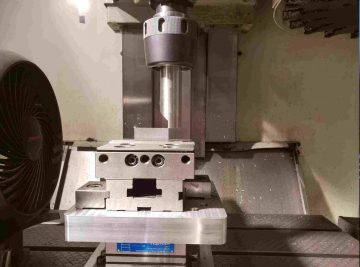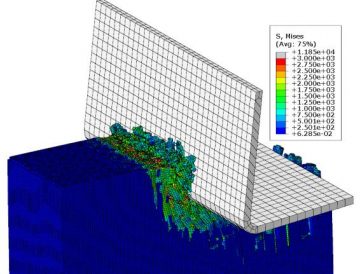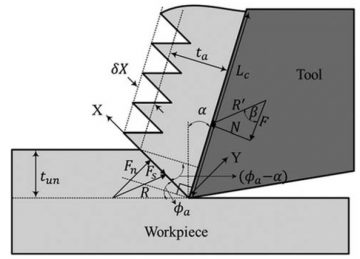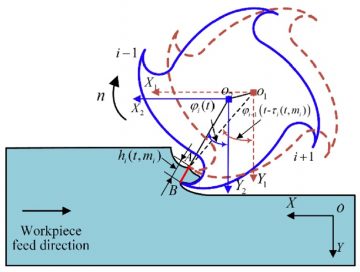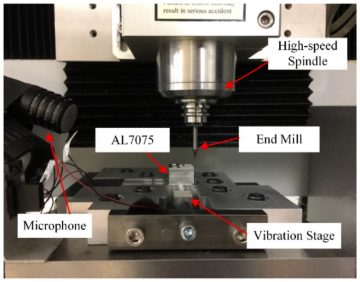| 1. Machining of carbon fiber reinforced polymers (CFRP).
Machining of carbon fiber reinforced polymer (CFRP) is a necessary process to achieve the final geometry and surface quality of the components used in the aerospace and automotive industries. The machining mechanism varies with fiber orientation and tool geometry due to its two-constituent structure. We develop new analytical and numerical mechanics models, and perform experimental investigations to understand the machining mechanism of CFRP, which are used to optimize the process and tool design.
Song, C. and Jin, X., 2020. Shearing-buckling mechanism in orthogonal cutting of unidirectional carbon fiber reinforced polymer. Journal of Materials Processing Technology, 280, p.116612.
2. Hybrid additive manufacturing – machining processes. This research focuses on the effect of parameters in hybrid additive and machining processes on the mechanical properties, geometric distortion, and surface integrity of the manufactured components. An in-house direct laser deposition machine has been developed to perform additive manufacturing of metal alloys, with temperature monitoring and process control capabilities.
|
|
3. Tool-chip interaction in the machining of advanced metal alloys. For high-strength advanced metallic alloys such as titanium alloys, nickel alloys, and bulk metallic glasses, the cutting productivity is limited by high cutting temperature, rapid tool wear, and poor quality of the finished surface. These adverse effects are mainly attributed to the shear band formation and unique tool-chip interaction, which involves stress and temperature oscillations in the deformation zones. This study focuses on the fundamental mechanism of shear localization and tool-chip contact in machining components made of these materials, and the development of improved machining technology (e.g. vibration-assisted machining) to improve tool life and surface quality.
Fazlali, M., Ponga, M. and Jin, X., 2021. Analytical Modeling of Shear Localization in Orthogonal Cutting Processes. Journal of Manufacturing Science and Engineering, pp.1-45.
4. Mechanics and dynamics of micro-cutting process. Micro-cutting technology has the advantage of producing miniature parts with complex and three-dimensional features for a broad range of materials. The cutting condition and tool geometry need to be optimized to reach smooth surface finish with desired accuracy and prevent premature breakage of cutting tool. Material microstructure, tool-workpiece interaction, tool edge geometry and machining dynamics bring academic and industrial challenges due to downsizing of the chip load and tool dimension. The research activities aim to characterize the material deformation, tool vibration and surface generation for micro/nano-cutting and precision manufacturing processes. A new dynamic model of aerostatic spindle including the journal and thrust bearings is developed for the purpose of micro-cutting with air-bearing spindles. Reynolds equations are used to model the dynamics of a 4-degree-of-freedom (DOF) aerostatic journal bearing and a 3-DOF aerostatic thrust bearing. Finite element model of the spindle shaft is developed based on the Timoshenko beam theory considering the centrifugal and gyroscopic effects and is coupled with the bearing to construct the dynamic model of the whole aerostatic spindle.Based on the developed model, the effects of tool overhang length, rotating speed, air film thickness, and supply air pressure on the frequency response function of the spindle are investigated comprehensively. The proposed dynamic model of the aerostatic spindle is able to provide useful guidance for structure design and process planning for micro-machining.
Shi, J., Cao, H., Maroju, N.K. and Jin, X., 2020. Dynamic modeling of aerostatic spindle with shaft tilt deformation. Journal of Manufacturing Science and Engineering, 142(2).
5. Vibration-assisted machining for enhancing the machining performance. Vibration-assisted machining is a process in which external vibration at certain amplitude and frequency is superimposed to the original cutting motion. It has been demonstrated that vibration assistance is able to improve tool life and surface quality in milling process. This project focuses on the study of how the vibration assistance parameters influence the shear deformation of workpiece material, and the chatter stability of the milling process. The results will be used to optimize the assisted vibration amplitude and frequency in order to maximize the benefit of the vibration assistance.
Gao, J. and Jin, X., 2019. Effects of Ultrasonic Vibration Assistance on Chip Formation Mechanism in Cutting of Ti–6Al–4V. Journal of Manufacturing Science and Engineering, 141(12).
|
|
6. Surface texturing for improving surface tribological property.
The objective of this project is to determine the material deformation modes of the workpiece and develop control mechanism in the surface texturing of for improving surface tribological property. This research includes a novel technique of fabricating the molding insert through direct surface texturing on BMG by diamond micro milling with planar vibration of the workpiece, and a novel surface texturing process using milling with spindle speed modulation.
     |
| Huang, F. and Jin, X., 2021. Surface texture generation using high-feed milling with spindle speed modulation. Precision Engineering, 72, pp.13-24. Maroju, N.K. and Jin, X., 2018. Vibration-assisted dimple generation on bulk metallic glass. Procedia Manufacturing, 26, pp.317-328. |
|
Sponsors NSERC Discovery Grant; NSERC CRD; NSERC CANRIMT2; Canada Research Chairs Program;
|
|
|
